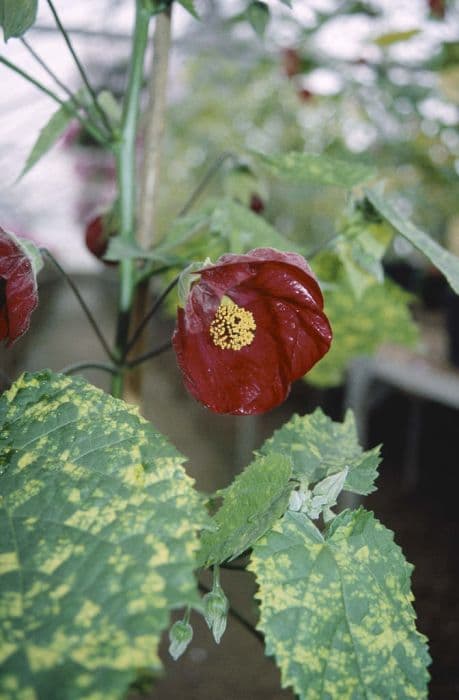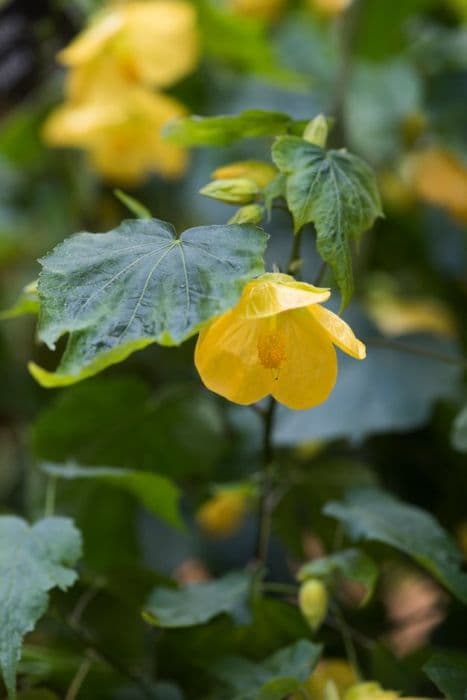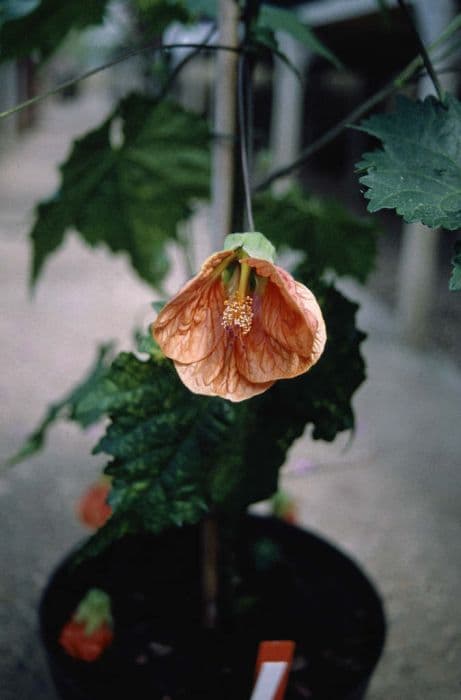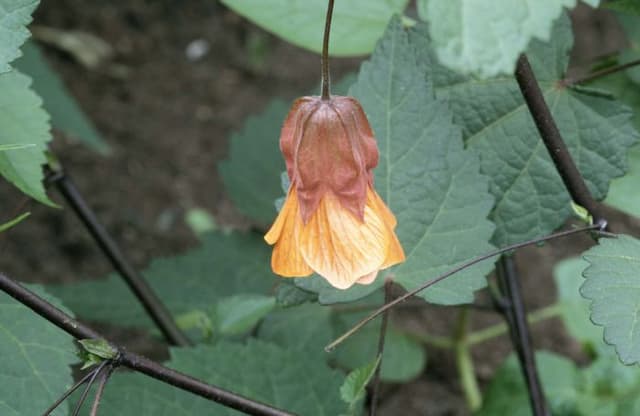Velvetleaf Corynabutilon × suntense

ABOUT
Corynabutilon × suntense, commonly known as the Velvet tree mallow, is a deciduous shrub notable for its attractive foliage and showy flowers. The leaves are heart-shaped, featuring a velvety texture with a rich green hue that adds a lush appearance to the plant profile. The Velvet tree mallow produces large, bell-shaped flowers that are typically shades of lavender to violet, providing a striking contrast against the foliage. These blossoms are often veined with darker colors, which adds depth and interest to the overall flower display. The flowers hang gracefully from the branches, and during the blooming season, the plant becomes a focal point in the garden due to its prolific flowering habit. The Velvet tree mallow's branching structure is somewhat open, giving it a light and airy presence. Throughout the year, the plant maintains an appealing aesthetic, with the seasonal changes of foliage and flowers bringing variation and beauty to its presentation.
About this plant
 Names
NamesFamily
Malvaceae
Synonyms
Sunten Abutilon, Velvetleaf, Flowering Maple
Common names
Abutilon × suntense.
 Toxicity
ToxicityTo humans
There is limited specific information available on the toxicity of the Violet shrub to humans. Generally, plants in the Malvaceae family are not known for severe toxicity to humans, and there is no widespread documentation of the Violet shrub causing significant harm if ingested. However, as with any plant, individual allergic reactions or sensitivities may occur, and it is always wise to exercise caution and avoid ingesting plants that are not traditionally recognized as food.
To pets
The toxicity of the Violet shrub to pets, like dogs and cats, is not well-documented, and there is no specific information suggesting that this plant is highly toxic to pets. While the Malvaceae family, to which the Corynabutilon × suntense belongs, does not commonly include severely poisonous plants, caution is still advised. If a pet ingests this plant and shows signs of ill health such as vomiting, diarrhea, or unusual behavior, you should consult a veterinarian. Always keep an eye on pets and prevent them from chewing on ornamental plants.
 Characteristics
CharacteristicsLife cycle
Perennials
Foliage type
Semi-deciduous
Color of leaves
Green
Flower color
Lilac
Height
10 feet (3 meters)
Spread
6 feet (1.8 meters)
Plant type
Shrub
Hardiness zones
8
Native area
Hybrid
Benefits
 General Benefits
General Benefits- Ornamental Value: Corynabutilon × suntense, also known as Velvetleaf, has strikingly large and beautiful mauve flowers that add aesthetic value to gardens and landscapes.
- Attracts Pollinators: The flowers produce nectar and attract bees, butterflies, and other pollinators that are vital for the ecosystem.
- Drought Tolerance: Velvetleaf is relatively drought-tolerant once established, making it suitable for xeriscaping and water-wise gardens.
- Low Maintenance: This plant requires minimal care, making it appealing for gardeners who prefer less demanding garden plants.
- Adaptability: It can adapt to a variety of soil types, although it prefers well-drained soils, showing resilience in different planting conditions.
- Architectural Interest: The tall stems and large leaves of Velvetleaf provide a strong architectural point of interest, especially in mixed borders or as a specimen plant.
- Seasonal Interest: In addition to its spring and summer bloom, it offers seasonal interest with its foliage in the autumn.
- Privacy and Screening: When planted in groups, Corynabutilon × suntense can provide a moderate level of privacy and can be used for screening unwanted views.
- Provides Shade: Larger specimens can offer a modest amount of shade, creating cooler micro-environments within a garden.
- Wildlife Habitat: The plant can serve as a habitat for certain species of birds and small mammals that use it for shelter and nesting materials.
 Medical Properties
Medical PropertiesThis plant is not used for medical purposes.
 Air-purifying Qualities
Air-purifying QualitiesThis plant is not specifically known for air purifying qualities.
 Other Uses
Other Uses- The flowering of Corynabutilon × suntense, known as flowering maple, can be used as a nectar source for bees and other pollinating insects, contributing to the local ecosystem.
- Corynabutilon × suntense's branches can be incorporated into floral arrangements and decorations for their aesthetic appeal.
- The plant's dried seed pods can be used in crafts to add a unique texture to wreaths or dried flower compositions.
- With its robust size, the flowering maple can serve as a natural screen or backyard privacy fence when grown in groups.
- The large leaves of Corynabutilon × suntense can be used as a green mulch to suppress weeds and retain soil moisture in garden beds.
- The bark fibers may be utilized for paper making by hobbyists interested in creating plant-based artisan papers.
- The flowering maple can act as a host plant for specific moth and butterfly larvae, thus supporting biodiversity.
- Its woody structure can provide winter habitats for beneficial insects and small wildlife when left unpruned.
- The plant can be part of a sensory garden for its velvety foliage and brightly colored flowers, providing tactile and visual stimulation.
- Corynabutilon × suntense's vibrant blooms can be used as a natural dye for fabrics in small-scale or craft dyeing processes.
Interesting Facts
 Feng Shui
Feng ShuiThe plant Corynabutilon × suntense, commonly known as Velvetleaf, is not used in Feng Shui practice.
 Zodiac Sign Compitability
Zodiac Sign CompitabilityThe Velvetleaf is not used in astrology practice.
 Plant Symbolism
Plant Symbolism- Resilience and Strength: Corynabutilon × suntense, commonly known as Velvetleaf, often represents resilience due to its hardy nature and strong wood.
- Rarity and Uniqueness: As a less common garden plant, Velvetleaf can symbolize the value and beauty in rarity and uniqueness.
- Protective Qualities: Velvetleaf plants have a robust appearance which might symbolize protective qualities, sheltering smaller plants in a garden setting.
 Water
WaterViolet Churcu bells should be watered deeply once a week, allowing the soil to dry out slightly between waterings. During the active growing season in spring and summer, it may require more frequent watering, especially if the weather is particularly hot or windy. Aim to apply about 1 gallon of water per square foot of soil every week. Adjust this amount during the hotter periods or if the plant is in a container, which may need water every few days. It's important to avoid overwatering as this can lead to root rot.
 Light
LightViolet Churcu bells thrive in full sun to partial shade. The ideal location would offer morning sunlight and afternoon shade, especially in hotter climates. Ensure that the plant gets at least 6 hours of sunlight each day for optimal growth and flowering. However, too much direct, harsh sunlight in the peak of summer can cause leaf scorch, making dappled sunlight conditions ideal.
 Temperature
TemperatureViolet Churcu bells prefer a temperate climate with temperatures ranging from 50°F to 80°F. They can survive minimum temperatures down to about 40°F but should be protected from frost. The ideal temperature range for these plants is between 60°F and 75°F. Avoid exposing Violet Churcu bells to temperatures above 90°F for prolonged periods, as this can stress the plant.
 Pruning
PruningPrune Violet Churcu bells in late winter or early spring to maintain their shape and size, and encourage new growth and better air circulation. Remove any dead or damaged wood, and cut back old stems to promote flowering. It is also beneficial to deadhead spent flowers throughout the growing season to encourage additional blooms.
 Cleaning
CleaningAs needed
 Soil
SoilThe shrubby Indian mallow prefers a fertile, well-draining soil mix with added organic matter such as compost or peat. Its optimal soil pH ranges from 5.5 to 7.5, slightly acidic to neutral.
 Repotting
RepottingShrubby Indian mallow typically requires repotting every 2 to 3 years, ideally in the spring before the onset of the growing season.
 Humidity & Misting
Humidity & MistingShrubby Indian mallow thrives in moderate humidity levels but can tolerate a range of conditions; ensure good air circulation to prevent any issues.
 Suitable locations
Suitable locationsIndoor
Provide bright, indirect light and ample space for shrubby Indian mallow.
Outdoor
Ensure full sun to partial shade and protect from strong winds for shrubby Indian mallow.
Hardiness zone
8-10 USDA
 Life cycle
Life cycleThe life cycle of the Velvet Abutilon (Corynabutilon × suntense) starts with seed germination, occurring in a warm, moist substrate, often in spring. After germination, the seedling stage is characterized by the emergence of the first leaves, and as the plant grows, it enters the vegetative stage, developing a shrubby structure with woody stems. During the reproductive stage, typically in late spring or early summer, the Velvet Abutilon produces large bell-shaped flowers that are attractive to pollinators. Following pollination, fruits develop which are dry capsules containing seeds that, when mature, are dispersed by splitting open. The Velvet Abutilon is a perennial plant, so after the flowering and fruiting stages, it may enter a period of dormancy in colder climates or reduce growth in winter before commencing the cycle anew with the next growing season. Pruning of old wood after flowering can encourage new growth and more prolific blooming in subsequent years.
 Propogation
PropogationPropogation time
Spring to early summer
Propogation: The most popular method for propagating the Violet Tree (Corynabutilon × suntense) is through semi-ripe stem cuttings. This is typically done in late summer. To propagate, you take cuttings that are about 4 to 6 inches (10 to 15 centimeters) long from the current year's growth. The lower leaves of the cuttings are removed, and the cut end can be dipped in a rooting hormone to increase success. The cuttings are then planted in a moist, well-draining potting mix and kept in a warm area with indirect sunlight. It's important to maintain humidity around the cuttings, which can be achieved by covering them with a plastic bag or placing them in a propagator. Roots usually develop within several weeks, after which the new plants can eventually be potted on or planted out.





![Abutilon [Yellow Trumpet]](/_next/image?url=https%3A%2F%2Fplants-admin.emdemapps.com%2Fimages%2Fplants%2F%2Fimages%2F604b5caa8b4fb.png&w=640&q=75)


